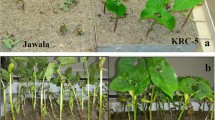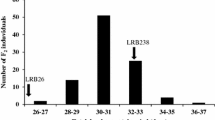Abstract
Rust in bean (Phaseolus vulgaris L.), caused byUromyces appendiculatus (Pers.) Unger var.appendiculatus [ =U. phaseoli (Reben) Wint.], is a major disease problem and production constraint in many parts of the world. The predominant form of genetic control of the pathogen is a series of major genes which necessitate the development of efficient selection strategies. Our objective was focused on the identification of RAPD (random amplified polymorphic DNA) markers linked to a major bean rust resistance gene block enabling marker-based selection and facilitating resistance gene pyramiding into susceptible bean germplasm. Using pooled DNA samples of genotyped individuals from two segregating populations, we identified two RAPD markers linked to the gene block of interest. One such RAPD, OF10970 (generated by a 5′-GGAAGCTTGG-3′ decamer), was found to be closely linked (2.15±1.50 centi Morgans) in coupling with the resistance gene block. The other identified RAPD, OI19460 (generated by a 5′-AATGCGGGAG-3′ decamer), was shown to be more tightly linked (also in coupling) than OF10970 as no recombinants were detected among 97 BC6F2 segregating individuals in the mapping population. Analysis of a collection of resistant and susceptible cultivars and experimental lines, of both Mesoamerican and Andean origin, revealed that: (1) recombination between OF10970 and the gene block has occurred as evidenced by the presence of the DNA fragment in several susceptible genotypes, (2) recombination between OI19460 and the gene block has also occurred indicating that the marker is not located within the gene block itself, and (3) marker-facilitated selection using these RAPD markers, and another previously identified, will enable gene pyramiding in Andean germplasm and certain Mesoamerican bean races in which the resistance gene block does not traditionally exist. Observations of variable recombination among Mesoamerican bean races suggested suppression of recombination between introgressed segments and divergent recurrent backgrounds.
Similar content being viewed by others
References
Bentolila S, Guitton C, Bouvet N, Sailland A, Nykaza S, Freyssinet G (1991) Identification of an RFLP marker tightly linked to theHt1 gene in maize. Theor Appl Genet 82:393–398
Chase CD, Ortega VM, Vallejos CE (1991) DNA restriction fragment length polymorphisms correlate with isozyme diversity inPhaseolus vulgaris L. Theor Appl Genet 81:806–811
Christ BJ, Groth JV (1982) Inheritance of resistance in three cultivars of beans to the bean rust pathogen and the interaction of virulence and resistance genes. Phytopathology 72:771–773
Diers BW, Mansur L, Imsande J, Shoemaker RC (1992) MappingPhytophthora resistance loci in soybean with restriction fragment length polymorphism markers. Crop Sci 32:377–383
Echavez R, Freytag GF (1982) Mexico 309 as a source of resistance to bean rust (abstract) Phytopathology 72:169
Echt CS, Erdahl LA, McCoy TJ (1992) Genetic segregation of random amplified polymorphic DNA in diploid cultivated alfalfa. Genome 35:84–87
Edwards KC, Johnstone C, Thompson C (1991) A simple and rapid method for the preparation of plant genomic DNA for PCR analysis. Nucleic Acids Res 19:1349
Freytag GF, Kelly JD, Adams MW, Lopez Rosa J, Beaver J, Echavez Badel R (1985) Registration of two navy bean germplasm lines L226-10 and L227-1. Crop Sci 25:714
Gepts P, Bliss FA (1985) F1 hybrid weakness in common bean. J Hered 76:447–450
Gepts P, Debouck D (1991) Origin, domestication, and evolution of the common bean (Phaseolus vulgaris L.) In: van Schoonhoven A, Voysest O (eds) Common beans: research for crop improvement. CAB International, UK, pp 7–54
Kelly JD, Adams MW (1987) Phenotypic recurrent selection in ideotype breeding of pinto beans. Euphytica 36:69–80
Khairallah MM, Adams MW, Sears BB (1991) Mitochondrial genome size variation and restriction fragment length polymorphisms in threePhaseolus species. Theor Appl Genet 82:321–328
Klein-Lankhorst R, Rietveld P, Verkerk R, Weide R, Gebhardt C, Koornneef M, Zabel P (1991) RFLP markers linked to the root knot nematode resistance geneMi in tomato. Theor Appl Genet 81:661–667
Martin GB, Williams JGK, Tanksley SD (1991) Rapid identification of markers linked to aPseudomonas resistance gene in tomato by using random primers and near-isogenic lines. Proc Natl Acad Sci USA 88:2336–2340
Melchinger AE (1990) Use of molecular markers in breeding for oligogenic disease resistance. Plant Breed 104:1–19
Michelmore RW, Paran I, Kessell RV (1991) Identification of markers linked to disease resistance genes by bulked segregant analysis: a rapid method to detect makers in specific genomic regions using segregating populations. Proc Natl Acad Sci USA 88:9828–9832
Miklas PN, Stavely JR, Kelly JD (1993) Identification and potential use of a molecular marker for rust resistance in common bean. Theor Appl Genet 85:745–749
Muehlbauer GJ, Staswick PE, Specht JE, Graef GL, Shoemaker RC, Keim P (1991) RFLP mapping using near-isogenic lines in the soybean [Glycine max (L.) Merr.]. Theor Appl Genet 81:189–198
Nodari RO, Koinange EMK, Kelly JD, Gepts P (1992) Towards an integrated linkage map of common bean. I. Development of genomic DNA probes and levels of restriction fragment length polymorphism. Theor Appl Genet 84:186–192
Paran I, Kesseli R, Michelmore R (1991) Identification of restriction fragment length polymorphism and random amplified polymorphic DNA markers linked to downy mildew resistance genes in lettuce, using near-isogenic lines. Genome 34:1021–1027
Paterson AH, DeVerna JW, Lanini B, Tanksley SD (1990) Fine mapping of quantitative trait loci, using selected overlapping recombinant chromosomes, in an interspecific cross of tomato. Genetics 124:735–742
Paterson AH, Tanksley SD, Sorrells ME (1991) DNA markers in plant improvement. Adv Agron 46:39–90
Quiros CF, Hu J, This P, Chevre AM, Delseny M (1991) Development and chromosomal localization of genome-specific markers by polymerase chain reaction inBrassica. Theor Appl Genet 82:627–632
Reiter RS, Williams JGK, Feldmann KA, Rafalski JA, Tingey SV, Scolnik PA (1992) Global and local genome mapping inArabidopsis thaliana by using recombinant inbred lines and random amplified polymorphic DNA. Proc Natl Acad Sci USA 89:1477–1481
Rick CM (1969) Controlled introgression of chromosomes ofSolanum pennellii intoLycopersicon esculentum: segregation and recombination. Genetics 62:753–768
Saghai-Maroof MA, Soliman KM, Jorgenson RA, Allard RW (1984) Ribosomal DNA spacer-length polymorphism in barley: Mendelian inheritance, chromosomal location, and population dynamics. Proc Natl Acad Sci USA 81:8014–8018
Saiki RK, Gelfand DH, Stoffel S, Scharf SJ, Higuchi R, Horn GT, Mullis KB, Erlich HA (1988) Primer-directed enzymatic amplification of DNA with a thermostable DNA polymerase. Science 239:487–491
Sarfatti M, Abied MA-, Katan J, Zamir D (1991) RFLP mapping ofI1, a new locus in tomato conferring resistance againstFusarium oxysporum F. sp.lycopersici race 1. Theor Appl Genet 82:22–26
Singh SP, Gutiérrez JA (1984) Geographical distribution of theDL 1 andDL 2 genes causing hybrid dwarfism inPhaseolus vulgaris L., their association with seed size, and their significance to breeding. Euphytica 33:337–345
Singh SP, Gutiérrez JA, Molina A, Urrea C, Gepts P (1991a) Genetic diversity in cultivated common bean. II. Markerbased analysis of morphological and agronomic traits. Crop Sci 31:23–29
Singh SP, Nodari R, Gepts P (1991b) Genetic diversity in cultivated common bean. I. Allozymes. Crop Sci 31:19–23
Sprecher S (1988) Isozyme genotype differences between the large-seeded and small-seeded gene pools inPhaseolus vulgaris L. Annu Rep Bean Improv Coop 31:36–37
Stavely JR (1983) A rapid technique for inoculation ofPhaseolus vulgaris with multiple pathotypes ofUromyces phaseoli. Phytopathology 73:676–679
Stavely JR (1984a) Genetics of resistance toUromyces phaseoli in aPhaseolus vulgaris line resistant to most races of the pathogen. Phytopathology 74:339–344
Stavely JR (1984b) Pathogenic specialization inUromyces phaseoli in the United States and rust resistance in beans. Plant Dis 68:95–99
Stavely JR, McMillan RT Jr. (1992) BARC-rust resistant bush market green bean gemplasm lines. HortScience 27:1052–1054
Stavely JR, Pastor-Corrales MA (1989) Rust. In: Schwartz HF, Pastor-Corrales MA (eds) Bean production problems in the tropics, 2nd edn. CIAT, Columbia, pp 159–194
Stavely JR, Steadman JR, Coyne DP, Lindgren DT (1989a) Belneb rust resistant-1 and -2 great northern dry bean germplasm. HortScience 24:400–401
Stavely JR, Steadman JR, McMillan RT (1989b) New pathogenic variability inUromyces appendiculatus in North America. Plant Dis 73:428–432
Stavely JR, Steinke J, McMillan RT, Grafton KF, Steadman JR, Kelly JD, Coyne DP, Lindgren DT, Silbernagel MJ (1992) Rust resistant bean germplasm releases. Annu Rep Bean Improv Coop 35:228–229
Steel RGD, Torrie H (1980) Principles and procedures of statistics, a biometrical approach. McGraw-Hill, New York
Suiter KA, Wendel JF, Case JS (1983) Linkage-1: a PASCAL computer program for the detection and analysis of genetic linkage. J Hered 74:203–204
USDA-SEA, Ag Exp Stn Univ Puerto Rico (1979) The release of four black bean cultivars: B-128, B-190, B-351, and 2B-5-1. Germplasm Release Notice
Welsh J, McClelland M (1990) Fingerprinting genomes using PCR with arbitrary primers. Nucleic Acids Res 24:7213–7218
Williams JGK, Kubelik AR, Livak KJ, Rafalksi JA, Tingey SV (1990) DNA polymorphisms amplified by arbitrary primers are useful as genetic markers. Nucleic Acids Res 18:6531–6535
Young ND, Zamir D, Ganal MW, Tanksley SD (1988) Use of isogenic lines and simultaneous probing to identify DNA markers tigthly linked to theTm-2a gene in tomato. Genetics 20:579–585
Yu ZH, Mackill DJ, Bonman JM, Tanksley SD (1991) Tagging genes for blast resistance in rice via linkage to RFLP markers. Theor Appl Genet 81:471–476
Author information
Authors and Affiliations
Additional information
Communicated by A. L. Kahler
Research supported by the Michigan Agricultural Research Station and the USDA-ARS. Mention of a trademark or a proprietary product does not constitute a guarantee or warranty of the product by the USDA and does not imply its approval to the exclusion of other products that may also be suitable
Rights and permissions
About this article
Cite this article
Haley, S.D., Miklas, P.N., Stavely, J.R. et al. Identification of RAPD markers linked to a major rust resistance gene block in common bean. Theoret. Appl. Genetics 86, 505–512 (1993). https://doi.org/10.1007/BF00838567
Received:
Accepted:
Issue Date:
DOI: https://doi.org/10.1007/BF00838567




